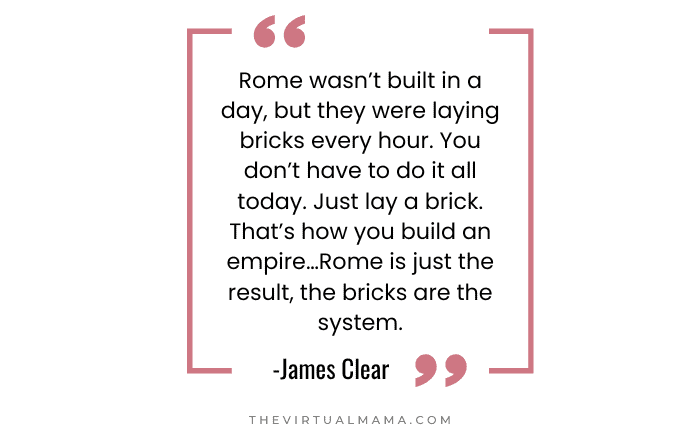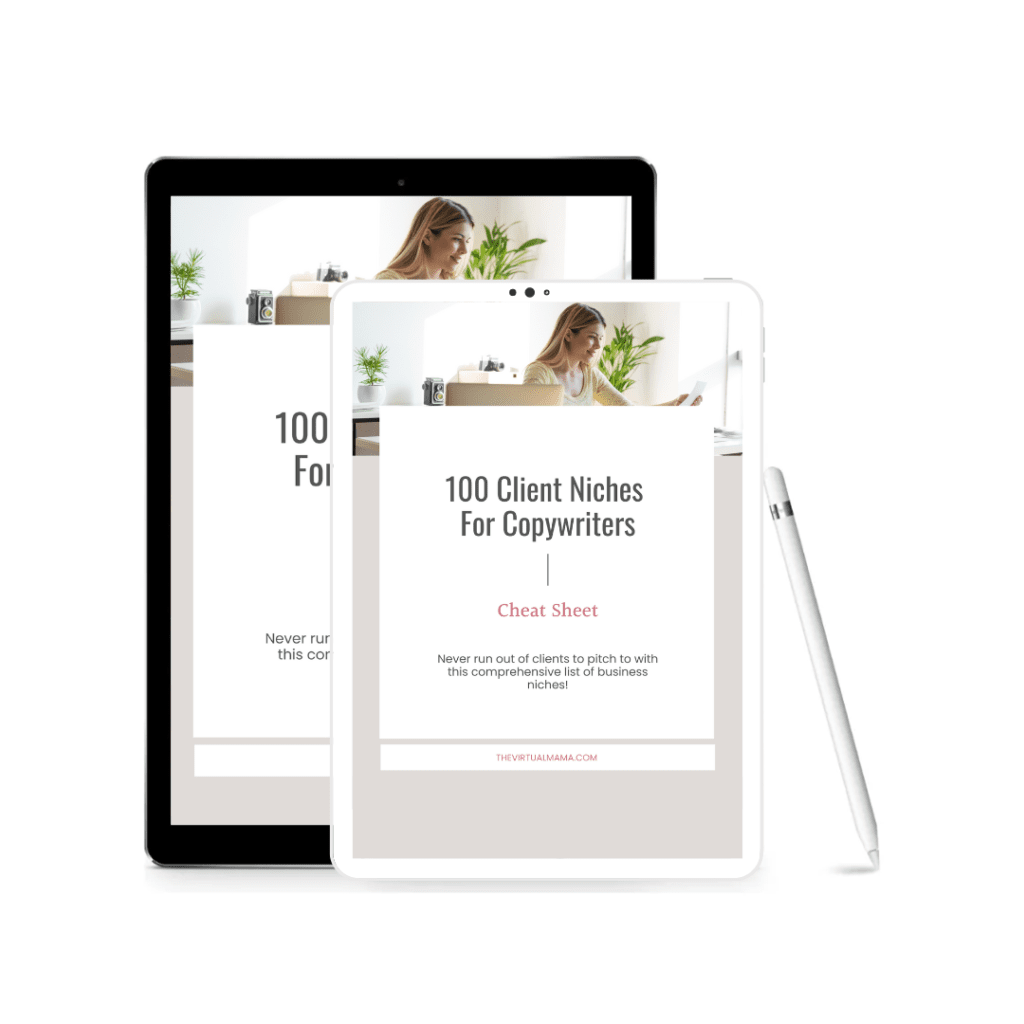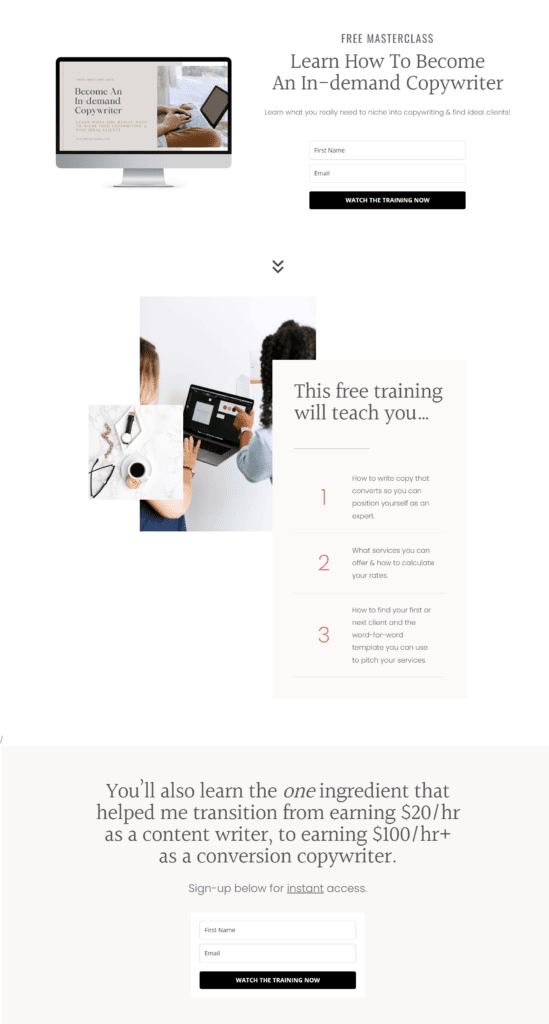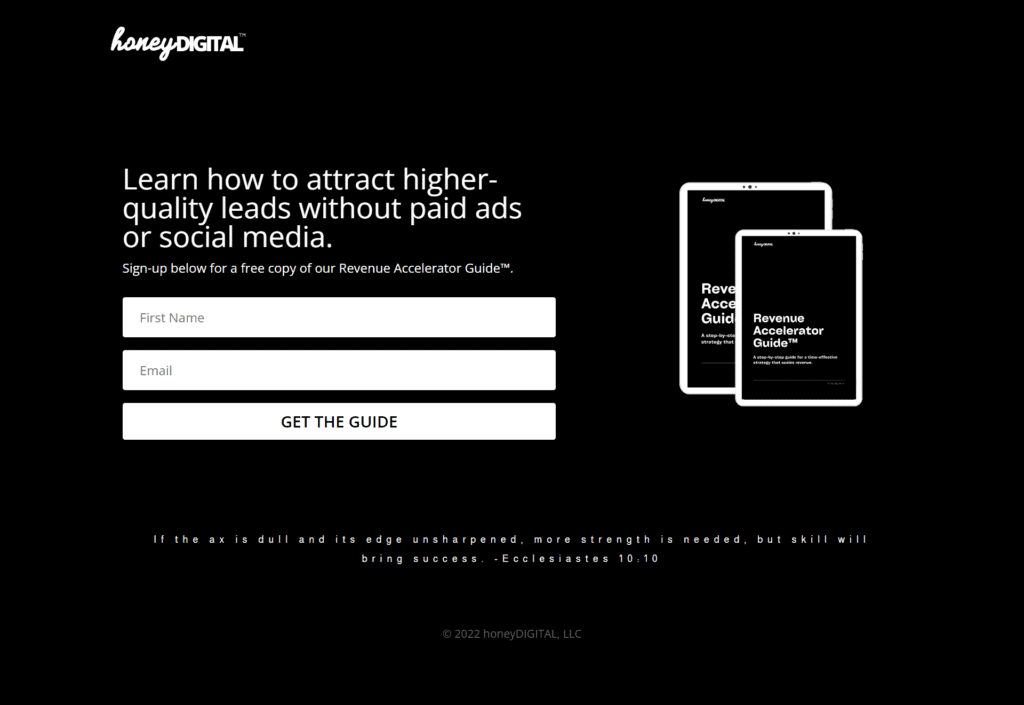Copywriting Business Plan (Make $50-$100/Hour As A Freelance Writer)
Create a copywriting business plan and launch your career.
If you’re looking to start a copywriting business from scratch or transition your current business to offer copy services, this copywriting business plan will give you everything you need to get started.
You’ll learn:
- How to start your copywriting business
- Copywriting services you can offer
- What to charge for copywriting
- A step-by-step action plan you can adjust to your busy schedule
This guide will help you overcome indecision and get the clarity that you need to move forward.
But first, I want to share something that’s personal, yet relevant to your business.
Three years ago I started a virtual assistant business. I was offering every service under the sun from social media marketing, to blog writing and administrative tasks.
I didn’t care what a client needed, I was ready to jump through 5 hoops to get the job.
^^ That’s no way to run a business.
Being a “generalist” is what kept me stuck making $20/hour…which isn’t bad at all, except for the fact I had to work 40 hours a week to hit a decent income. With multiple kids, that just wasn’t possible.
Here’s why I share this…
Copywriting is the perfect service for anyone who wants to specialize in a profitable, in-demand skill. You’ll be able to earn a full-time income working part-time hours.
(If you do choose to work full-time and earn even more, you totally can.)
Now let’s get into how you can get started.
Learning How To Write Copy
Now, if you have absolutely no copywriting knowledge or experience whatsoever, I highly recommend taking a pause on starting your business to actually learn the skill first.
(Cause, how can you offer to sell a service you know nothing about?)
If you’re already strong in your skillset, you can choose to keep developing your skills as you build your business and work with clients.
Otherwise, you need to learn the basics first.
Here are a few options to get started:
Start with my free copywriting guide to learn the basics.
This is truly an A to Z guide that starts with the very bare basics of what copywriting is, different kinds of copywriting, ,and how to implement copywriting tactics.
Take my free copywriting class, How To Become An In-demand Copywriter .
This is an in-depth class that will help you understand how to write copy, and also transition into offering it as a service. It’s the perfect option for beginner or mid-level writers who want to get to improve their skills.
Read copywriting books.
When I was first starting out, I purchased two books. The first was Copywriting: Successful Writing for Design, Advertising and Marketing by Mark Shaw. The second was The Adweek Copywriting Handbook by Joseph Sugarman.
Since then I’ve gone on to buy many other titles like Ogilvy On Advertising and more. (For a full list of the resources and tools I use in my business click here.)
Learn from other copywriters.
Getting feedback on your work and being able to ask questions is really important to grow as a copywriter. Not everyone has a community of copywriters they can go to, which is why I created Virtual Assistant Copywriters Collective.
It’s a free community for copywriters and other virtual biz owners to network and grow together.
Now, if you’re really set on developing your skills to the expert level, I highly recommend investing in a comprehensive training. One option I recommend is Copyland.
Once you go through the foundational resources I mentioned, a course like Copyland will help you advance your skills significantly.
(Copyland enrollment only opens twice a year, but you can click here to learn more about it.)
Set Up Your Copywriting Business
Once you learn the skills you need, you can start offering copywriting services.
Starting your own business is a leap of faith that requires pushing yourself out of your comfort zone.
As new and exciting as it is though, it requires planning. There’s a lot to think about when starting a business, but planning doesn’t have to mean overwhelm.
James Clear, the author of #1 New York Times bestseller, Atomic Habits, says “Rome wasn’t built in a day, but they were laying bricks every hour. You don’t have to do it all today. Just lay a brick. That’s how you build an empire…Rome is just the result, the bricks are the system.”

So, are you ready to start building your business?
Today, we’re going to “lay some bricks” together.
Here’s a step-by-step walkthrough of how to get started.
Decide On Your Services
Copywriters can provide many different services. Here are a few of them:
Website Copy
Nearly every business has a ‘www’ address, and if you have an online business such as eCommerce or selling digital products, you definitely need to have exceptional copy to make sales with your site.
Ad Copy
This could be print ads, but also for Google and social media ads.
Newsletter Copy
Some businesses send emails up to 2 or 3 times a week to nurture their audiences. This is a great writing niche that brings in consistent income each month.
Landing Pages
I love how MailChimp describes landing pages, so I’ll share their definition: “A landing page is a standalone web page that a person “lands” on after clicking through from an email, ad, or other digital location. Once they’re on your landing page, users are encouraged to take an action, such as joining your list or buying your products.”
Sales Pages
Sales pages are essentially a sales letter published on a standalone webpage. These are different from a homepage of a website because they only have one link or call to action (which is to purchase a product or service). There’s no navigation at the top because it will only distract the reader. The goal here is to get a user to read down the page and make a purchase.
(A sales page is a specific kind of landing page. Not all landing pages are necessarily sales pages, because some landing pages promote free content as well, like in the example I shared above.)
Email Sequences
These are a series of automated emails (typically 5-7) that are sent within a period of time to nurture or convert the reader into a customer.
Since copywriting is a developed skill, it helps to try different types of copy until you discover a niche that works for you.
If you have experience with a specific type of writing, you might want to start there. (Unless you’re ready to try something new.)
You might find you enjoy a specific kind of copy, and that’s when you might consider niching down (which we will cover later in this post).
Ultimately, your goal is to give your clients the best solution to their problem. You want to make them happy and excited about their decision to work with you. So find out what they need, and how you can align your skills and natural gifts to help them.
Set Your Copywriting Rates
Deciding on the rates to charge your clients is an essential “brick” in laying the foundation of your business, but I know how challenging that can be in the beginning.
You’ll want to consider:
- Your skill level and experience (are you a beginner, mid-level copywriter, or expert?)
- Scope of the project and complexity (the amount of work that needs to be done to complete the project from goals, deliverables, tasks, other expenses, deadlines, & etc.)
- Project turnaround time (what’s the timeline of the project from start to finish?)
- What you need to sustain your business (make sure your rates are sustainable in the long run and offer you a comfortable living—lower rates mean working more hours to meet your revenue goals.)
There are multiple ways you can charge clients…
- Hourly Pricing. This is really straightforward—you track your time, and charge the client your hourly rate for the time you worked. While I don’t recommend charging hourly, there is a place for it, especially if you plan to write for other agencies.
- Project-based Pricing. This is my favorite pricing model. It’s when you charge a fixed rate for the entire project, and regardless of how little or long it takes you, the rate is the same. I’ll share more in a bit about how to determine what to charge with this pricing model.
- Day Rates. It’s not uncommon for copywriters to have “day rates.” This is when a copywriter is selling their time rather than a finished piece of copy.
It’s important for both you and the client to understand that they’re paying for your time, not a deliverable. Be careful to set realistic expectations on what you’ll be able to accomplish in that time.
I don’t offer day rates unless it’s for a speaking gig or in-person event, but I believe they can be a great option for some copywriters.
I mentioned earlier that flat rates are my favorite way to charge for projects. Here’s why…
One of the reasons I niched down my services is I didn’t want to trade time for money.
Charging a flat rate enables you to get a fair rate, and not be penalized for completing your work faster. On the flipside, if you choose to work at a slower pace, the client isn’t penalized either.
Here’s how you can calculate a project rate for any service…
First, choose your internal hourly rate. This is the rate that you use to calculate your project fee, but it’s not going to be disclosed to the client.
Then, break down how long you expect the project to take you and multiply the two numbers together.

Check out the live video below to learn how you can earn more per hour with your copywriting services!
Gather Writing Samples
Writing samples are essential to your business. They showcase your talent as a writer and give clients a better understanding of your style or work.
Pro Tip: once you have selected all your writing samples, you’ll need somewhere to display them so potential clients can see your work.
You can use Canva to create a portfolio for free. Some copywriters (like my friend Phil Dorsett) use Adobe’s Portfolio Website, while others use a website or hosting platform like SquareSpace.
Copywriting portfolios can vary greatly from one copywriter to another. Whichever option you pick, the important thing is for you to showcase your value and personality.
If you haven’t worked with any clients yet, you can create your own writing samples (this is something I teach inside my course, Copyland).
It’s good practice to have at least 3-4 samples of the kind of writing you want to do. So, maybe you’ll have one email sample, one sales page sample, and one ad sample.
(I put my writing samples in a Google Drive folder, and link to it inside my portfolio.)
If you’d like feedback on your writing samples (which I recommend), you can share them in my free Facebook group here to get help from myself or other members.
Create A Client Process
Before landing clients, I highly recommend creating a client process so that you’ll look more professional, and give your clients a seamless experience.
Think about it, what if you went to a website and were ready to make a purchase, but there were no clear instructions on what to do next?
My guess is you won’t buy anything, and it’s the same principle with your clients.
Your client process is essential. There needs to be a clear process that you and your clients go through, so you both always know “what’s next.”
This will give you confidence as a copywriter, make you look professional, and give clients a better experience.
Have you considered these steps?
- How you’ll get paid. (What will you use to process payments?)
- How you work. (Your policies, working hours, how you communicate with clients)
- How you process your leads. (Clearly outline the next steps to book your services)
- Your onboarding process. (How will new clients integrate into your business?)
- Your process for doing the work & delivering it to clients. (What’s your copywriting process? What tools will you use?)
- Your offboarding process. (How will you transition clients out after a project is done?)
Your process can be as simple as a 4-part bullet point list (but you can make it more in-depth if you want).
Doing this upfront will help you feel prepared and make you look more professional because you and your client always know what to expect.
Choose Your Tools
If you’re starting out as a new copywriter, it’s best to start with simple tools in your business.
Don’t fall into the “shiny object” trap. You don’t need every software on the market, you just need a couple of tried-and-true programs to run your business when starting out (and some of them are free).
The more complex you make it, the more overwhelming the process will become.
Instead, ask yourself these three simple questions:
- What do I need right now to grow my business? (Think need versus want.)
- What can I afford right now? (You can always upgrade later.)
- Which tools can help take me to the next level?
- Which tools are compatible with my current systems?
A few of my favorite tools include:
- Wave or Stripe (Safely process payments from clients for free)
- Loom (A video messaging tool that helps you communicate instantly through shareable videos)
- Canva (Create beautiful graphics, presentations, and templates)
- Calendly (Easily schedule meetings with potential clients)
- ClickUp (A project management tool to plan, track, and collaborate on nearly anything in your business)
- MailerLite (Email marketing tool and landing page builder)
- Google Drive (Store and work on shared files with your clients)
Develop A Strong Brand For Your Business
Your branding is the way your business presents itself publicly.
While it does include your logo, fonts and website colors – it’s much more than that.
Your branding includes the tone and vocabulary you use in your copy, your core values, mission, messaging, and how others perceive you.
A strong brand will help you stand out from the competition and give your business a personality that customers can relate to in their daily lives.
While there is a lot that goes into branding, I’m going to cover a few key elements here to help you get started quickly.
Choose A Niche
A niche is the specific portion of a market you choose to serve.
For example, if you’re an author, your specific niche might be writing children’s books, devotionals, or books on self-development , business management, or finance.
As a copywriter, you can do the same thing.
You can choose to focus on specific niches such as email copy, sales page copy, or choose a niche within a specific industry like SaaS, ecommerce, or digital products.
The possibilities are endless. It all depends on your interests, goals, and skills.
You don’t have to niche down right away, in fact when you’re first starting it might benefit you to offer general copywriting services.
But there are some benefits to having a niche:
You become an expert
When you’re focused on one aspect of copywriting or a particular industry, you can establish yourself as an expert in that area. That increases your perceived value, so you can charge higher rates.
Less competition
Picking a unique niche narrows down the competition and can help you stand out more.
Distinguish yourself more quickly
When you’re known for a specialization, it can be easier to establish yourself more quickly than offering general services.
If you’d like niche ideas for your business, check out my freebie, 100 Client Niches For Copywriters.
Create Your Value Proposition
A value proposition is a clear statement or promise that communicates why people should consider your business over your competitors.
Creating one is a key step in your copywriting business plan.
Here are some examples of value propositions from other known companies. (Any of these sound familiar?)
The Smartest Way to Get Around. (Uber)
The Experience IS the Product. (Apple iPhone)
Be More Productive at Work with Less Effort. (Slack)
Melts in your mouth, not in your hand. (M&M)
One app to replace them all. (ClickUp)
When you’re creating your value proposition, you want to be as unique as possible. Think about the special gifts, talents, and experiences you bring to the table.
For example, maybe you’re fluent in multiple languages and your value proposition is you write conversion focused copy for multilingual businesses, and make it easier for them to speak to diverse audiences without having a scattered brand message.
Think outside the sandbox, and pinpoint those qualities that make you unique.
Write Your Elevator Pitch
Think about how fast an elevator ride goes.
Elevator rides might be 10 or 20 seconds, but usually not more than a minute.
That’s about how long it should take you to share your pitch.
An elevator pitch is a brief way to introduce the purpose of your business and the people you serve.
It captures key points that make your business unique to help you make a quick connection with someone. It should quickly stimulate the interest of the customer, help them process the vision of your business, and make them want to work with you.
According to Zety.com, your elevator pitch should include 3 things:
- Provide a very brief introduction to your business
- Highlight how well you can serve. Consider the PAR formula (Problem—Action—Result)
- Make an offer to solve a problem
Like your writing samples, I recommend getting feedback on your elevator pitch. You can choose to get feedback from other copywriters, but also talk to other business owners and ask them what they think.
Getting direct feedback on your elevator pitch will help you gage if you’re on the right track or need to go back to the drawing board.
If you need somewhere to start, you can also share that in the the Facebook community too.
Curate A Style For Your Brand
Part of what differentiates your brand from competitors, is your brand style.
This can refer to the visual aesthetic of your business, as well as your content and brand messaging too.
As an example, here are two landing pages I pulled from my own businesses:
This landing page is from The Virtual Mama. The style is feminine, airy, and light hearted. My copy is very casual, fun, and sometimes sarcastic.
This landing page is from my marketing agency, honeyDIGITAL. The brand style is a day-and-night difference from what you see here at The Virtual Mama (and that’s because it speaks to a different audience).
The copy uses casual language, but isn’t quirky at all. I keep a mostly serious tone.
The branding is black and white, while The Virtual Mama uses tones of red, brown, and grey.
Can you note the style differences?
If I’m honest, a lot of the core content and information is actually very similar, but the style and manner in which it’s presented is entirely different.
You want to make sure that your brand style is attractive to whoever you’re targeting.
If you’re targeting C-Suite execs in Fortune 500 companies, you probably shouldn’t have pink, glittery graphics on your website.
On the other hand, if you’re looking to work with women entrepreneurs, you might want to consider using feminine elements in your brand style and copy.
Start Marketing Your Copywriting Business
People can’t support your business if they don’t even know it exists.
Have you made an intentional effort to share your business (or are you secretly hoping they’ll just one day come across your website, Instagram, or Facebook page)?
Just like anything else, marketing requires you to be intentional.
If you don’t know where to start, try different things until you find what works for you.
Here are a few ways I recommend marketing your copywriting business when you’re starting out.
Reach Out To Your Personal Network
Sometimes we underestimate the connections we’ve already made or the people who are a part of our close network.
Believe it or not, more people need copywriters than you think.
Think of your past colleagues, friends, family, members of your church, the person in your kickboxing class, your neighbor who just launched a business, or even a local bakery.
Let them know about your new business and how you can help them. Even if they don’t book with you right away, they might outsource your services in the future.
You might be an answer to someone’s prayers, but you’ll never find out if you don’t try.
Choose Your Marketing Channels
There are tons of free places you can market your copywriting services.
Whatever you decide to use, the key to success is consistency.
I challenge you to start marketing your business using at least 1-2 of the channels listed below.
- LinkedIn (Great for professional networking and career development)
- Facebook (Great for joining related professional groups)
- Instagram (Great for sharing video content)
- Local events (A great way to form real connections with other businesses)
I also want to recommend another platform for any ladies reading this post (sorry guys…you can skip this part).
It’s called Like Minded Collective. I met the founder earlier this year and worked with her on some email copy.
After doing more research on the platform, I became a huge fan personally and have been an active member.
Not only can you promote your business without any restrictions on the feed, but they have frequent workshops and networking events. What I love about it is other members are more open to making new connections than on other platforms.
You can click here to create a free account.
Create A Marketing Plan
Now that you’ve announced what you do to your network and decided on the marketing channels you’re going to use, it’s time to create a plan.
Your copywriting marketing plan should include:
Your business mission, vision, and values (to communicate the purpose and provide insight)
An overview of your market and competition (the process of determining your competitors)
A clearly defined target audience (who you’re serving)
Clearly outlined marketing strategy (the marketing channels you’ll use, and more importantly, how you plan to use them)
A starter budget (the money saved for your business)
Conclusion On Writing A Copywriting Business Plan
If you’re looking for a copywriting business plan to launch your business, the steps in this post will set you on the right track.
Leave me a comment and let me know, what next step do you need to take? Are you ready to work on your business plan?
Looking for more?
How To Successfully Transition Into Copywriting (Step-By-Step Plan)
How To Write A Copywriting Proposal (Free Template)
Content Writing Vs Copywriting (10 Differences Every Writer Should Know)










